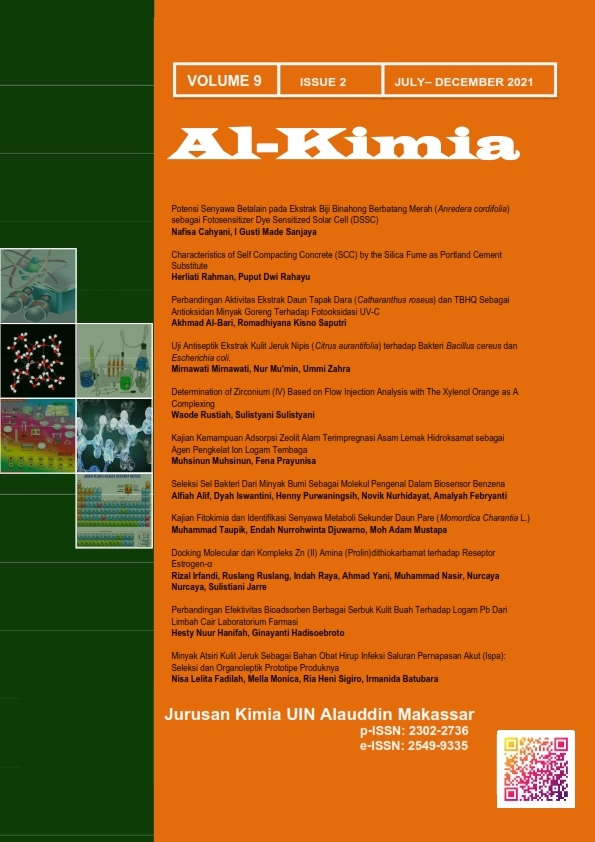Docking Molecular dari Kompleks Zn(II)Amina (Prolin)dithiokarbamat terhadap Reseptor Estrogen-α
Abstract
Estrogen-α (ER-α) is a major target in cancer therapy. Targeting the ER-α target protein is known to slow the proliferation of breast cancer cells. The purpose of this study was to determine the interaction of the complex compound Zn(II)Prolinedithiocarbamate against the Estrogen-α Receptor. The Zn(II)Prolinedithiocarbamate complex was predicted canonical SMILE by Cheminfo online application (O=C(O)C1CCCN1C2S[Zn]S2) and modeled with online corina to obtain a three-dimensional structure. The structure of the complex compound Zn(II)Prolinedithiocarbamate interacted with Estrogen receptor alpha protein to test its potential anticancer activity. Molecular docking results show the interaction of the Zn(II)Prolinedithiocarbamate complex with the Estrogen- receptor on the amino acid residues ARG394, LEU387, GLU353, LEU346, LEU349, and PHE404. The Zn(II)Prolinedithiocarbamate complex interacts directly with ER-α in the estrogen region which causes the failure of the interaction between estrogen and the estrogen receptor, so it can be predicted that the Zn complex has activity as an ER-α inhibitor and has the potential to be developed in the treatment of breast cancer.
Downloads
References
Adeyemi, J. O., & Onwudiwe, D. C. (2018). Organotin(IV) Dithiocarbamate Complexes: Chemistry and Biological Activity. Molecules 2018, Vol. 23, Page 2571, 23(10), 2571. https://doi.org/10.3390/MOLECULES23102571
Adjiri, A. (2017). DNA Mutations May Not Be the Cause of Cancer. Oncology and Therapy 2017 5:1, 5(1), 85–101. https://doi.org/10.1007/S40487-017-0047-1
Arjmand, F., Parveen, S., & Mohapatra, D. K. (2012). Synthesis, characterization of Cu(II) and Zn(II) complexes of proline-glycine and proline-leucine tetrapeptides: In vitro DNA binding and cleavage studies. Inorganica Chimica Acta, 388, 1–10. https://doi.org/10.1016/j.ica.2012.03.019
Bai, Z., Gust, R. (2009). Breast Cancer, Estrogen Receptor and Ligands. Arch. Pharm. Chem, 342, 133–149.
Ferreira, Isabella P., Geraldo M. de Lima., Eucler B., Paniago, Carlos B. Pinheiro., James L. Wardell ., and S. M. S. V. W. (2015). Study of metal dithiocarbamate complexes, Part V. Metal complexes of [S2CN(CH2CH(OMe)2]: a standard dimeric zinc dithiocarbamate structural motive, a rare cadmium dithiocarbamate coordination polymer, and a hydrated sodium dithiocarbarmate complex, with a. ICA, 11(011).
Guney, G. E. (2018). A novel Zn(II) complex loaded solid lipid nanoparticles for breast cancer treatment: Synthesis, characterization and cytotoxic studies. A Novel Zn(II) Complex Loaded Solid Lipid Nanoparticles for Breast Cancer Treatment: Synthesis, Characterization and Cytotoxic Studies.
H, T., Y, Z., & Z, P. (2009). Autocrine regulation of cell proliferation by estrogen receptor-alpha in estrogen receptor-alpha-positive breast cancer cell lines. BMC Cancer, 9, 31–31. https://doi.org/10.1186/1471-2407-9-31
Hassan, E. A., & Zayed, S. E. (2014). Dithiocarbamates as Precursors in Organic Chemistry; Synthesis and Uses. Http://Dx.Doi.Org/10.1080/10426507.2013.797416, 189(3), 300–323. https://doi.org/10.1080/10426507.2013.797416
Hua, H., Zhang, H., Kong, Q. et al. (2018). Mechanisms for estrogen receptor expression in human cancer. Exp Hematol Oncol, 7(24).
Irfandi, R., Prihantono, P., Raya, I., Kartina, D., & Riswandi, R. (2019). Synthesis, Characterization and Anticancer Studies of Fe(II)Cysteinedithiocarbamate Complex. Ii. https://doi.org/10.4108/eai.2-5-2019.2284628
Moverare-Skrtic, S., Borjesson, A.E., Farman, H.H., Sjorgen, K., Windahl, S.H., Lagerquist, M.K., Andersson, A., Stubelius, A., Carlsten, H., Gustafsson, J., Ohlsson, C. (2013). The Estrogen Receptor Antagonist ICI 182.780 can Act Both as an Agonist and an Inverse Agonist when Estrogen Receptor α AF-2 is Modified. Proceedings of the National Academy of Sciences, 111(3), 1180–1185.
MR, S., PJ, C., & PA, F. (2009). The cancer genome. Nature, 458(7239), 719–724. https://doi.org/10.1038/NATURE07943
Prihantono, Irfandi, R., Raya, I., & Warsinggih. (2020). Potential anticancer activity of Mn (II) complexes containing arginine dithiocarbamate ligand on MCF-7 breast cancer cell lines. Annals of Medicine and Surgery, 60(October), 396–402. https://doi.org/10.1016/j.amsu.2020.11.018
Ritacco, I., Russo, N., & Sicilia, E. (2015). DFT Investigation of the Mechanism of Action of Organoiridium(III) Complexes As Anticancer Agents. Inorganic Chemistry, 54(22), 10801–10810. https://doi.org/10.1021/acs.inorgchem.5b01832
Rogachev, I., Gusis, V., Gusis, A., Cortina, J. L., Gressel, J., & Warshawsky, A. (1999). Spectrophotometric determination of copper complexation properties of new amphiphilic dithiocarbamates. Reactive and Functional Polymers, 42(3), 243–254. https://doi.org/10.1016/S1381-5148(98)00083-2
Sastry, M., Lowrie, J.F., Dixon, S.L., Sherman, W. (2010). Large-scale systematic analysis of 2D fingerprint methods and parameters to improve virtual screening enrichments. J. Chem. Inf. Model, 50(5), 771–784.
Shareef, M., Ashraf, M. A., & Sarfraz, M. (2016). Natural cures for breast cancer treatment. Saudi Pharmaceutical Journal, 24(3), 233–240. https://doi.org/10.1016/J.JSPS.2016.04.018
Subin Kumar, K., Reena, V. N., & Aravindakshan, K. K. (2021). Synthesis, anticancer and larvicidal activities of a novel Schiff base ligand, 3-((2-((1-(4-hydroxyphenyl)ethylidene)amino)ethyl)imino)-N-(p-tolyl)butanamide and its Mn(II), Fe(III), Co(II), Ni(II) and Zn(II) complexes. Results in Chemistry, 3, 100166.
Yamamoto-Ibusuki, M., Arnedos, M., Andre, F. (2015). Targeted Therapies for ER+/HER2- Metastatic Breast Cancer. BMC Medicine, 13, 137.
Authors who publish with this journal agree to the following terms:
1) Authors retain copyright and grant the journal right of first publication with the work simultaneously licensed under a Creative Commons Attribution License that allows others to share the work with an acknowledgement of the work's authorship and initial publication in this journal.
2) Authors are able to enter into separate, additional contractual arrangements for the non-exclusive distribution of the journal's published version of the work (e.g., post it to an institutional repository or publish it in a book), with an acknowledgement of its initial publication in this journal.
3)Authors are permitted and encouraged to post their work online (e.g., in institutional repositories or on their website) prior to and during the submission process, as it can lead to productive exchanges, as well as earlier and greater citation of published work (See The Effect of Open Access).


